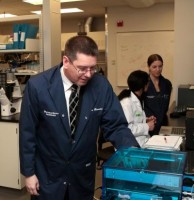 The new method for producing paper-based screening could allow easy identification of E. coli and Salmonella by consumers.
The new method for producing paper-based screening could allow easy identification of E. coli and Salmonella by consumers.
Researchers at McMaster University, in Ontario, Canada, have developed a simplified way to diagnose bacterial and respiratory infections, using letters and symbols that appear on a test paper to indicate contamination in food, people or the environment, eScienceNews.com reports.
Office inkjet printers can print the “bio-inks” the scientists have created, which produce DNA molecules on the page that emit a signal when a pathogen is present. Once printed, the sensor can be used straight away, similar to pH paper.
John Brennan, Director of the Biointerfaces Institute at McMasters, said: “For patients suspected of having infectious diseases like C. diff, this technology allows doctors to quickly and simply diagnose their illnesses, saving time and expediting what could be life-saving treatments.
“This method can be extended to virtually any compound, be it a small molecule, bacterial cell or virus.”
The research continues in its formative stage, but it has the potential to overcome the current issues with biosensing techniques; that they are labour-intensive, inconvenient and expensive and not easily mass produced.
Brennan says the new technology is also important as it may be put to use in medical fields where quick answers are desperately needed in fighting disease.
“We could conceivably adapt this for numerous applications which would include rapid detection of cancer or monitoring toxins in the water supply,” stated Brennan. “There are hundreds of possibilities.”
